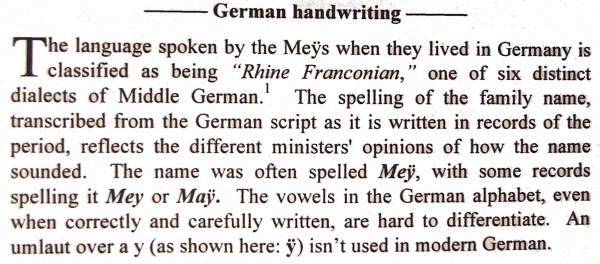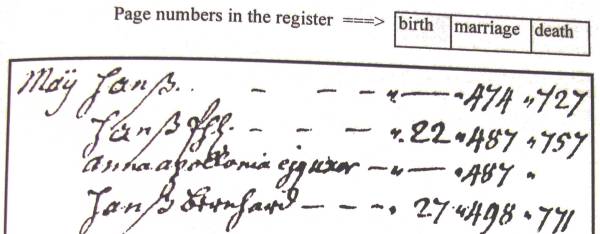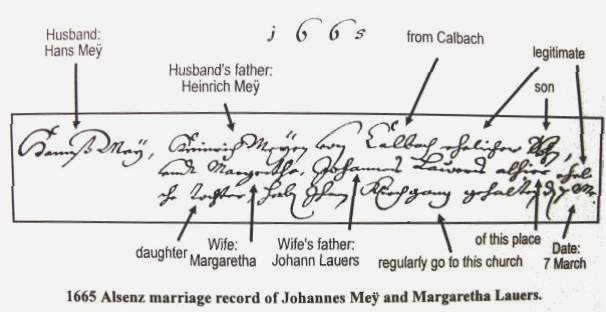|
Spellings of the May family name Mey Meÿ Meij - May Maÿ Maij
by
Fred T. May Return to What's New For a number of years I have wondered about the original spelling of our family name. Recently I received an inquiry to this web site from a man in the Netherlands with the surname Mey. As I was responding to him, I thought it was a good opportunity for me to ask for some assistance in questions I have about transcribing our family name. After reading the following notes, you can better understand why I had the question. A summary of his response is at the end of this page. Another source to explain the written versions of our May name is found in a brief summary in Handwriting Guide: German Gothic ** Conclusion ** I think the use of ÿ in the early spelling of the name as Meÿ or Maÿ is an accurate way to translate the script written in the church registers of Meisenheim, Alsenz and Niederhausen an der Nahe, where our May ancestors lived from the mid-1500s to the mid-1700s. The origin on the ÿ notation came from the letters ij in early German Gothic script. These dots should not be referred to as an "umlaut." The German umlauted vowels are ä, ö, and ü. Generations of the family that lived prior to our known records from the mid-1500s probably also lived somewhere in the greater Rhine River Valley. The Nahe River and its tributaries, the Glan and Alsenz Rivers, lie in the western section of this large valley. When we recently placed a new stone on the graves of our ancestors, John & Sarah Phillips May, on Shelby Creek in Pike County, KY, three different spellings of the family name were place on the stone. See photos of this stone John was the only son of our immigrant ancestor, Frantz Peter Meÿ/Maÿ.
Background Notes In 1996-98, when I was researching original German documents from registers of three churches in the Rheinland Palatinate in Germany for my book, The Shoemaker's Children, I found an unusual letter in the spelling of our family name. I noted this in the Introduction with the following paragraph.
A few years ago someone suggested that the letter I had transcribed as ÿ might be ij, as used in the Dutch language. It is easy to show that handwritten English script in lower case would make ij look like ÿ. Below are a few of many examples I found in these church and government records that illustrate the handwritten spelling of our surname.
The first example is from the beginning of an index to records of all the family members in the register of the church in Alsenz, from 1656 to 1766. The first entry is for Hans Maÿ. His full name was Johannes Maÿ [1638-1720] and he was the patriarch of the family in Alsenz. Note that the spelling appears to be Maÿ but it could also be transcribed as Maij.
The second document records the marriage of Johannes in 1665. The German spelling could be transcribed as Meÿ. Close inspection of the middle letter looks like a German e, which is not open like an a. German scholars, who had access to the manumission papers signed by members of our family when they were preparing to immigrate to America in 1748, transcribed the family name as Mey. This spelling is on page 304 of Pennsylvania German Immigrants 1709-1786, edited by Don Yoder in 1980.
Dots or dashes over what appears to be a y also appears in a number of dates in church documents. The following dates are written with the birth records of two of the May sons born in Niederhausen.
18 J:
(Julian Calendar) Maÿ (May) Note that these dates used the Julian calendar. The official change to the more accurate Gregorian calendar, which makes corrections for leap years, were first decreed by Pope Gregory in 1582, but was slow to be adopted throughout the world.
When Johann Leonhardt Maÿ and his brother, Frantz Peter Maÿ, made their "Oaths to the Government" on September 5, 1748, they signed their names as shown below.
When I met a 7th cousin in Alsenz, Germany in 2001 he said that he and his ancestors for a number of generations spelled their surname as May. However, he commented that he recognized the use of dots or dashes as shown in the signatures above.
Matthijs Mey from the Netherlands responded in 2007: The "ij" is a Dutch letter but also a German letter. It consist of an "i" and a "j". It is also a name of a water besides Amsterdam. In the German language an "y" with an Umlaut is not known. (at least I don't know, and I had German-class a number of years and I work at an german-company). You suggest that your ancestors may have moved from Holland to Germany and then to America. I think this is not likely because the handwriting you send me is so called " Suttelin" . This is old German handwriting. The second reason is that in Germany as well in Holland the letter "ij" does exsits and is not strange at all. I think your family was called Maij (as you see in the signature) and not May (with an Umlaut). The third reason is that in those days (before 1811) there was no local and national government that controlled names. Napoleon introduced this in Holland in 1811 and I think in the same time in Germany. Before 1800 many people couldn't read or write and spelled it as they liked. The church-people (priests etcetera) wrote down the names in the Birth and Marriage-books as they assumed the names would be spelled. Therefore you see a number of varieties on the name Maij (May, Mey or Meij)
Handwriting
Guide: German Gothic Occasionally two dots were also used over the y (ÿ) and over an e as in Noël (Noël) and Michaël (Michaël). In these instances, there is no change in pronunciation of the letter beneath. The dots over the y are carried over from Latin when the double i at the end of a word was written, ‘ij’. (Latin did not have the letter j or y).
Return to Top | What's New |



